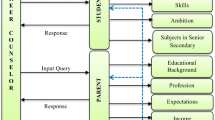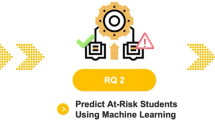Abstract
Students are the future of a nation. Personalizing student interests in higher education courses is one of the biggest challenges in higher education. Various AI and ML approaches have been used to study student behaviour. Existing AI and ML algorithms are used to identify features for various fields, such as behavioural analysis, economic analysis, image processing, and personalized medicine. However, there are major concerns about the interpretability and understandability of the decision made by a model. This is because most AI algorithms are black-box models. In this study, explain- able AI (XAI) aims to break the black box nature of an algorithm. In this study, XAI is used to identify engineering students’ interests, and BRB and SP-LIME are used to explain which attributes are critical to their studies. We also used (PCA) for feature selection to identify the student cohort. Clustering the cohort helps to analyse the between influential features in terms of engineering discipline selection. The results show that there are some valuable factors that influence their study and, ultimately, the future of a nation.







Similar content being viewed by others
Explore related subjects
Discover the latest articles, news and stories from top researchers in related subjects.Data Availability
The datasets of our study were publicly available from our github repository (https://github.com/linkoncuetbd/Student-survey-data).
References
Aggarwal, M. (2021). Modeling a decision-maker’s choice behavior through perceived values. IEEE Transactions Systems, Man, and Cybernetics: Systems, 51(3), 1933–1944.
Burkart, N., & Huber, M. F. (2021). A survey on the explainability of supervised machine learning. Journal of Artificial Intelligence Research, 70, 245–317.
Chen, Y.-J., Tanaka, K., Tanaka, M., Tsai, S.-H., & Wang, H. O. (2021). A novel path-following-method-based polynomial fuzzy control design. IEEE Transactions on Cybernetics, 51(6), 2993–3003.
Choi, T.-M., Chan, H. K., & Yue, X. (2017). Recent development in big data analytics for business operations and risk management., 47(1), 81–92.
Dutta, S., Behera, L., & Nahavandi, S. (2021). Skill learning from human demonstrations using dynamical regressive models for multitask applications. IEEE Transactions on Systems, Man, and Cybernetics: Systems, 51(1), 659–672.
Fiok, K., Karwowski, W., Gutierrez, E., & Wilamowski, M. (2021). Analysis of sentiment in tweets addressed to a single domain-specific twitter account: comparison of model performance and explainability of predictions. Expert Systems with Applications, 115771.
Gautam, C., Tiwari, A., Suresh, S., & Ahuja, K. (2021). Adaptive online learning with regularized kernel for one-class classification. IEEE Transactions on Systems, Man, and Cybernetics: Systems, 51(3), 1917–1932.
Guo, F., Li, G., Wen, C., Wang, L., & Meng, Z. (2021). An accelerated distributed gradient-based algorithm for constrained optimization with application to economic dispatch in a large-scale power system. IEEE Transactions on Systems, Man, and Cybernetics: Systems, 51(4), 2041–2053.
Güven, C., Seipel, D., & Atzmueller, M. (2021). Applying asp for knowledge-based link prediction with explanation generation in feature-rich networks. IEEE Transactions on Network Science and Engineering, 8(2), 1305–1315.
Howell, S. K., Wicaksono, H., Yuce, B., McGlinn, K., & Rezgui, Y. (2019). User centered neuro-fuzzy energy management through semantic-based optimization., 49(9), 3278–3292.
Islam, M. A., Anderson, D. T., Pinar, A. J., Havens, T. C., Scott, G., & Keller, J. M. (2020). Enabling explainable fusion in deep learning with fuzzy integral neural networks. IEEE Transactions on Fuzzy Systems, 28(7), 1291–1300.
Yang, J.-B., Liu, J., Wang, J., Sii, H.-S., & Wang, H.-W. (2006). Belief rule-base inference methodology using the evidential reasoning approach-RIMER. IEEE Trans. Syst., Man, Cybern., 36(2):266–285
Kamal, M. S., Chowdhury, L., Dey, N., Fong, S. J., & Santosh, K. (2021a). Explainable ai to analyze outcomes of spike neural network in covid-19 chest x-rays. In 2021 IEEE International Conference on Systems, Man, and Cybernetics (SMC), IEEE, pp 3408–3415
Kamal, M. S., Dey, N., Chowdhury, L., Hasan, S. I., & Santosh, K. (2022). Explainable AI for glaucoma prediction analysis to understand risk factors in treatment planning., 71, 1–9.
Kamal, M. S., Northcote, A., Chowdhury, L., Dey, N., Crespo, R. G., & Herrera-Viedma, E. (2021). Alzheimer’s patient analysis using image and gene expression data and explainable-ai to present associated genes. IEEE Transactions on Instrumentation and Measurement, 70, 1–7.
Liu, C., Wang, K., Wang, Y., & Yuan, X. (2021a). Learning deep multi-manifold structure feature representation for quality prediction with an industrial application. 1–1
Liu, Z.-Z., Wang, Y., & Wang, B.-C. (2021). newblock Indicator-based constrained multiobjective evolutionary algorithms. IEEE Transactions on Systems, Man, and Cybernetics: Systems, 51(9), 5414–5426.
Mansoori, A., & Effati, S. (2021). Parametric ncp-based recurrent neural network model: A new strategy to solve fuzzy nonconvex optimization problems. IEEE Transactions on Systems, Man, and Cybernetics: Systems, 51(4), 2592–2601.
Solari, M., Vizquerra, M. I., & Engel, A. (2022). Students’ interests for personalized learning: an analysis guide.
Sun, Q., & Ge, Z. (2021). Deep learning for industrial KPI prediction: When ensemble learning meets semi-supervised data., 17(1), 260–269.
Tian, Y., He, C., Cheng, R., & Zhang, X. (2021). A multistage evolutionary algorithm for better diversity preservation in multiobjective optimization. IEEE Transactions on Systems, Man, and Cybernetics: Systems, 51(9), 5880–5894.
Van Campenhout, R., Jerome, B., & Johnson, B. G. (2023). Engaging in student-centered educational data science through learning engineering. In A. Peña-Ayala (Ed.), Educational Data Science: Essentials, Approaches, and Tendencies (pp. 3–40). Springer Nature Singapore. Series Title: Big Data Management.
Wang, B.-C., Li, H.-X., Zhang, Q., & Wang, Y. (2021). Decomposition-based multiobjective optimization for constrained evolutionary optimization. IEEE Transactions on Systems, Man, and Cybernetics: Systems, 51(1), 574–587.
Wang, F.-Y., Filev, D. P., Pedrycz, W., Li, H., and White, C. C. (2018). Guest editorial from intelligent control to smart management of cyber-physical-social systems: A celebration of 70th anniversary of cybernetics by norbert wiener. 48(12), 3278–3279
Wang, Y., Sun, X., Li, J., & Yang, Y. (2021). Intelligent fault diagnosis with deep adversarial domain adaptation. IEEE Transactions on Instrumentation and Measurement, 70, 1–9.
Wu, X., Gu, Y., Tao, J., Li, G., Han, J., & Xiong, N. (2021). An effective data-driven cloud resource procurement scheme with personalized reserve prices. IEEE Transactions on Systems, Man, and Cybernetics: Systems, 51(8), 4693–4705.
Yang, L., Song, S., Li, S., Chen, Y., & Huang, G. (2021). Graph embedding-based dimension reduction with extreme learning machine. IEEE Transactions on Systems, Man, and Cybernetics: Systems, 51(7), 4262–4273.
Yang, Z., Yang, J., Rice, K., Hung, J.-L., & Du, X. (2020). Using convolutional neural network to recognize learning images for early warning of at-risk students., 13(3), 617–630.
Author information
Authors and Affiliations
Contributions
All authors contributed equally to the writing of this paper. All authors read and approved the final manuscript for submission.
Corresponding author
Ethics declarations
Competing interest
The authors declare that they have no competing interests.
Rights and permissions
Springer Nature or its licensor (e.g. a society or other partner) holds exclusive rights to this article under a publishing agreement with the author(s) or other rightsholder(s); author self-archiving of the accepted manuscript version of this article is solely governed by the terms of such publishing agreement and applicable law.
About this article
Cite this article
Ghosh, S., Kamal, M.S., Chowdhury, L. et al. Explainable AI to understand study interest of engineering students. Educ Inf Technol 29, 4657–4672 (2024). https://doi.org/10.1007/s10639-023-11943-x
Received:
Accepted:
Published:
Issue Date:
DOI: https://doi.org/10.1007/s10639-023-11943-x




